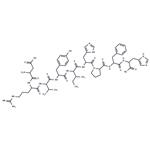Chemical Properties
White powder
Definition
ChEBI: Angiotensin (1-9) is a nine amino acid peptide which is formed when angiotensin converting enzyme 2 (ACE2) hydrolyzes the carboxy terminal leucine from angiotensin I. It is a anti-cardiac hypertrophy agent. It has a role as a human metabolite, a rat metabolite, an antihypertensive agent and a cardioprotective agent. It is a tautomer of an angiotensin (1-9) dizwitterion.
Biological Activity
angiotensin i/ii (1-9) is a peptide (asp-arg-val-tyr-ile-his-pro-phe-his) containing the amino acids 1-9 that are converted from angiotensin i/ii peptide.angiotensin i is formed by the action of renin on angiotensinogen, which has 12 amino acids and is an α-2-globulin produced constitutively and released into the circulation mainly by the liver. renin cleaves the peptide bond between the leucine (leu) and valine (val) residues on angiotensinogen, creating the ten-amino acid peptide angiotensin i. angiotensin i is converted to angiotensin ii (aii) through removal of two c-terminal residues by the enzymeangiotensin-converting enzyme (ace), primarily through ace within the lung.angiotensin is a peptide hormone that causes vasoconstriction and a subsequent increase in blood pressure. angiotensin also stimulates the release of aldosterone, which promotes sodium retention in the distal nephron so that drives blood pressure up.figure1 formula of angiotensin i/ii (1-9)
References
1. Basso N, Terragno NA (December 2001). "History about the discovery of the renin-angiotensin system". Hypertension 38 (6): 1246–9. 2. Richard A. Preston. et. (1998). “Age-Race Subgroup Compared With Renin Profile as Predictors of Blood Pressure Response to Antihypertensive Therapy”. JAMA. 1998;280(13):1168-1172.3. Williams GH, Dluhy RG (2008). "Chapter 336: Disorders of the Adrenal Cortex". In Loscalzo J, Fauci AS, Braunwald E, Kasper DL, Hauser SL, Longo DL. Harrison's principles of internal medicine. McGraw-Hill Medical.


